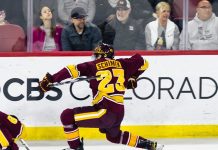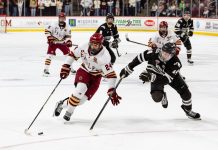“As for the men who perpetrated these acts, there are no adequate words of condemnation. Their barbarism will stand as their shame.” — British Prime Minister Tony Blair.
The hockey world was rocked along with the rest of the world by the events of Sept. 11. The full effects of those attacks have been thoroughly covered by the international media as well as here on U.S. College Hockey Online. Most of the sports world took until Sept. 17 to even begin getting back to business, but in the college hockey recruiting game, much like the game itself, there was not that much time to recover.
The Thursday after the attacks the Hy-Vee Buc Bowl, the first of two junior hockey preseason tournaments, began in Des Moines, Iowa. Although the tournament did take Friday off for the National Day of Mourning, the United States Hockey League, which hosted the event, believed the tournament must be played.
“Commissioner [Gino] Gasparini struggled with that decision,” said USHL President Butch Johnson. “Obviously when the nation takes a day of mourning we will also. But in the next breath, the President says we have to move on.”
This next weekend, the Wells Fargo Super 16 was played in Cedar Rapids, Iowa. Some coaches couldn’t attend the Buc Bowl due to cancelled flights, in particular along the East Coast. Some, however, did manage to make it to the tournaments in spite of the many travel problems they encountered. With many flights cancelled coaches had to make other plans to get to the tournament locations.
Ohio State assistant coach Casey Jones decided to drive to the Buc Bowl after the tragedy, and stayed in the state of Iowa for the few days between the tournaments rather than make the trip back to Columbus. Michigan State assistant David McAuliffe made several attempts to get to Des Moines by plane, but decided to wait until the Super 16 because the earliest the airlines could get him to Des Moines was Saturday, leaving only the last one-third of the tournament for evaluations.
The importance of junior hockey preseason tournaments to college recruitment can’t be overstated. The current NCAA recruiting rules are strict. In fact, strict might be a bit of on understatement.
NCAA teams are allowed only seven total contacts with a player over the course of a year. Only three of those seven are actual “contacts.” The other four are evaluations. Each of these preseason tournaments, however, counts as only one evaluation. Confused yet? Let’s try to explain.
Though the coaches might get to see a player play in three or four games in a tournament, it counts as only one of the seven evaluations. That means it’s possible to see a player perform in six games during the two preseason tournaments and have it count as only two evaluations, leaving five more possible contacts. If a coach sees the player in six regular-season games, he would have only one possible contact remaining with that player.
There is another large factor in the importance of the pre-season junior hockey tournaments.
“It’s a good chance to compare several players against each other at the same time,” said McAuliffe, “to see if you’re on the right path.”
That’s not to say that any permanent decision is made on the performances in these tournaments. More than one coach in attendance stressed that this is just a starting point for recruiting efforts, stressing that some of the players have not played at all during the summer. One coach added that he would “check where they are in a month” to get a better idea if it was a player he might want to recruit.
“It gives us an early indicator of the talent pool in the league,” said Johnson, “It’s a great motivational tool for the players.”
As for the recruits themselves, it was obvious by the level of play that they were aware of the heavy scouting presence. The Danville Wings of the North American Hockey League, which sees far fewer scouts than the USHL during the regular season, finished the Super 16 with a 2-1 record. Danville may be the class of that league this season. It returns 12 Junior A veterans and also landed Left Winger Chris Busby, who spent last season with Brown University.
Due to more of those NCAA recruiting rules, college coaches are not permitted to comment on players who have not yet signed a letter of intent to attend a college. U.S. College Hockey Online will try to provide progress reports for some of the 2001-2002 recruits as soon as they begin to sign letters of intent.
Fortunately, college coaches were not the only ones attending the tournaments. The National Hockey League was also anxious to get a look at the future of college hockey. Scouts from several NHL organizations were in attendance, for the obvious reasons, and another reason, which, as was stated by more than one NHL scout, “is no secret.”
The man who is “no secret” is a 6-foot-2, 205-pound Austrian forward named Thomas Vanek. Vanek returns for his second season in the uniform of the Sioux Falls Stampede. Last season he was the cream of the USHL crop with 29 points (10-9) in only 20 USHL regular-season games.
The NHL scouts may have to wait, however. Vanek’s birthday is Jan. 19, 1984, meaning he would be too young to enter this years draft should he choose to go to college. If he chooses to opt-in to the draft rather than attend school, look for him to be an early-round pick.
Vanek was not the only player who impressed over the Super 16 weekend. College coaches can’t comment, so I’m going to have to go out on my own for this one. I’ve chosen two young men who were very impressive during the short time I watched them in their tournament games.
Ales Parez from the Chicago Steel provides very good skill at a forward position. The 6-2, 195-pounder from the Czech Republic is in his final year of junior hockey eligibility. If he puts on some weight he could develop into a very skilled power forward. Look for one of the more aggressive checking college squads to scoop him up.
Finally, a former teammate of Vanek should make a big impression this season in Topeka. Jon Booras is only 5-10 and 180 pounds, but plays much bigger. He showed his ability to play both an effective forward, and a threat from the point on the power play. It was also quite obvious in how he handled his teammates on the ice that some outstanding leadership potential is present in his game.
On a final note, it’s important for everyone in sports to help in the world’s healing process. A portion of the proceeds from last month’s games were donated to charities helping in the recovery effort. In Cedar Rapids, there were no searches. There were no metal detectors. In spite of the fear many people have at this time, the fans, scouts, and coaches gathered to watch hockey as one. Let’s hope that spirit spreads as quickly as possible.


